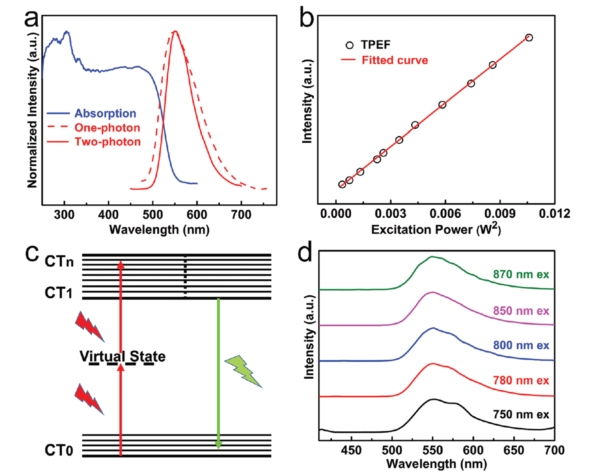
The emission of photons at shorter wavelength than the excitation often requires nonlinear optical (NLO) processes, and is highly important for a series of photonic applications such as microfabrication, data storage, and up-converted lasing. Among various NLO mechanisms, two-photon excited fluorescence (TPEF), the spontaneous emission of excited state produced by simultaneously absorbing two identical photons, is a third-order nonlinear process occurring efficiently in a number of organic conjugated chromophores. The design and synthesis of TPEF molecular materials have been studied for decades to elevate the efficiency of two-photon absorption (TPA) and consequently emissive recombination. A competingprocess is the frequency doubling of incident photons, namely second harmonic generation (SHG), which usually coexists with TPEF in these luminescent materials. Using centrosymmetric molecules can theoretically avoid the SHG effect and thus obtain only the TPEF upconversion signal. However, most of the efficient NLO dyes rely on the intramolecular charge-transfer (CT) feature in asymmetrical donor–acceptor configurations, and the centrosymmetric examples are limited to a few conjugated systems, for instance, trans-stilbene (TSB) and porphyrin derivatives.

Dai and their co-workers successfully synthesized the highly symmetric cocrystals of TSB and TCNB molecules, in which the two-photon related performance was greatly enhanced and SHG remained miniature compared with single components. This is attributed to the intermolecular CT interaction in TTC, leading to the enhancement of third-order nonlinear coefficient and the improvement of radiative recombination rate. Besides, the intermolecular CT states are delocalized and bring a wide distribution in energy levels, which broadens the excitation window for TPEF from TTC. Our findings reveal the importance of intermolecular CT in achieving high-performance NLO cocrystals, and open up a new route to the construction of NLO materials without complex molecular structures or complicated synthetic procedures.